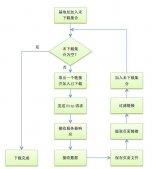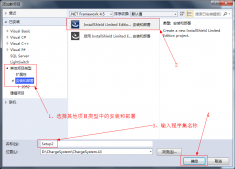公司项目中经常设计到串口通信,TCP通信,而且大多都是实时的大数据的传输,然后大家都知道协议通讯肯定涉及到什么,封包、拆包、粘包、校验……什么鬼的概念一大堆,说简单点儿就是要一个高效率可复用的缓存区。按照码农的惯性思维就是去百度、谷歌搜索看有没有现成的东西可以直接拿来用,然而我并没有找到,好吧不是很难的东西自己实现一个呗。开扯……
为什么要用环形队列?
环形队列是在实际编程极为有用的数据结构,它有如下特点:
它是一个首尾相连的FIFO的数据结构,采用数组的线性空间,数据组织简单。能很快知道队列是否满为空。能以很快速度的来存取数据。
因为有简单高效的原因,甚至在硬件都实现了环形队列。
C#完全实现(可直接使用)
鄙人新手这份代码肯定有不足之处,望大家指出交流,涉及到的多线程同步问题请调用者完成,不废话直接上代码。
|
1
2
3
4
5
6
7
8
9
10
11
12
13
14
15
16
17
18
19
20
21
22
23
24
25
26
27
28
29
30
31
32
33
34
35
36
37
38
39
40
41
42
43
44
45
46
47
48
49
50
51
52
53
54
55
56
57
58
59
60
61
62
63
64
65
66
67
68
69
70
71
72
73
74
75
76
77
78
79
80
81
82
83
84
85
86
87
88
89
90
91
92
93
94
95
96
97
98
99
100
101
102
103
104
105
106
107
108
109
110
111
112
113
114
115
116
117
118
119
120
121
122
123
124
125
126
127
128
129
|
public class RingBufferManager{ public byte[] Buffer { get; set; } // 存放内存的数组 public int DataCount { get; set; } // 写入数据大小 public int DataStart { get; set; } // 数据起始索引 public int DataEnd { get; set; } // 数据结束索引 public RingBufferManager(int bufferSize) { DataCount = 0; DataStart = 0; DataEnd = 0; Buffer = new byte[bufferSize]; } public byte this[int index] { get { if (index >= DataCount) throw new Exception("环形缓冲区异常,索引溢出"); if (DataStart + index < Buffer.Length) { return Buffer[DataStart + index]; } else { return Buffer[(DataStart + index) - Buffer.Length]; } } } public int GetDataCount() // 获得当前写入的字节数 { return DataCount; } public int GetReserveCount() // 获得剩余的字节数 { return Buffer.Length - DataCount; } public void Clear() { DataCount = 0; } public void Clear(int count) // 清空指定大小的数据 { if (count >= DataCount) // 如果需要清理的数据大于现有数据大小,则全部清理 { DataCount = 0; DataStart = 0; DataEnd = 0; } else { if (DataStart + count >= Buffer.Length) { DataStart = (DataStart + count) - Buffer.Length; } else { DataStart += count; } DataCount -= count; } } public void WriteBuffer(byte[] buffer, int offset, int count) { Int32 reserveCount = Buffer.Length - DataCount; if (reserveCount >= count) // 可用空间够使用 { if (DataEnd + count < Buffer.Length) // 数据没到结尾 { Array.Copy(buffer, offset, Buffer, DataEnd, count); DataEnd += count; DataCount += count; } else // 数据结束索引超出结尾 循环到开始 { System.Diagnostics.Debug.WriteLine("缓存重新开始...."); Int32 overflowIndexLength = (DataEnd + count) - Buffer.Length; // 超出索引长度 Int32 endPushIndexLength = count - overflowIndexLength; // 填充在末尾的数据长度 Array.Copy(buffer, offset, Buffer, DataEnd, endPushIndexLength); DataEnd = 0; offset += endPushIndexLength; DataCount += endPushIndexLength; if (overflowIndexLength != 0) { Array.Copy(buffer, offset, Buffer, DataEnd, overflowIndexLength); } DataEnd += overflowIndexLength; // 结束索引 DataCount += overflowIndexLength; // 缓存大小 } } else { // 缓存溢出,不处理 } } public void ReadBuffer(byte[] targetBytes,Int32 offset, Int32 count) { if (count > DataCount) throw new Exception("环形缓冲区异常,读取长度大于数据长度"); Int32 tempDataStart = DataStart; if (DataStart + count < Buffer.Length) { Array.Copy(Buffer, DataStart, targetBytes, offset, count); } else { Int32 overflowIndexLength = (DataStart + count) - Buffer.Length; // 超出索引长度 Int32 endPushIndexLength = count - overflowIndexLength; // 填充在末尾的数据长度 Array.Copy(Buffer, DataStart, targetBytes, offset, endPushIndexLength); offset += endPushIndexLength; if (overflowIndexLength != 0) { Array.Copy(Buffer, 0, targetBytes, offset, overflowIndexLength); } } } public void WriteBuffer(byte[] buffer) { WriteBuffer(buffer, 0, buffer.Length); }} |
调用实例
生产
|
1
2
3
4
5
6
7
8
9
10
11
12
13
14
|
int len = sConn.Receive(receiveBuffer, 0, receiveBuffer.Length, SocketFlags.None, out se);if (len <= 0) throw new Exception("disconnect..");if (len > 0){ lock (LockReceiveBuffer) { while (len + receiveBufferManager.DataCount > MAX_BUFFER_LEN) // 缓存溢出处理 { Monitor.Wait(LockReceiveBuffer,10000); } receiveBufferManager.WriteBuffer(receiveBuffer, 0, len); Monitor.PulseAll(LockReceiveBuffer); }} |
消费
|
1
2
3
4
5
6
|
lock (LockReceiveBuffer){ freame_byte = new byte[frameLen]; receiveBufferManager.ReadBuffer(freame_byte, 0, frameLen); receiveBufferManager.Clear(frameLen);} |
验证
TCP大数据连续测试一周没出现问题内存问题。
以上就是本文的全部内容,希望对大家的学习有所帮助,也希望大家多多支持服务器之家。
原文链接:http://www.cnblogs.com/fanqie-liuxiao/p/5712094.html















